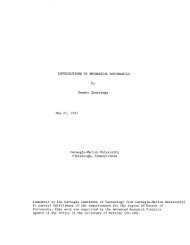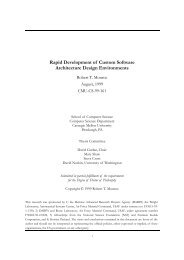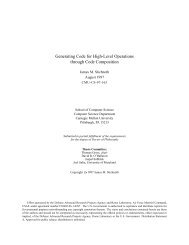Planning under Uncertainty in Dynamic Domains - Carnegie Mellon ...
Planning under Uncertainty in Dynamic Domains - Carnegie Mellon ...
Planning under Uncertainty in Dynamic Domains - Carnegie Mellon ...
Create successful ePaper yourself
Turn your PDF publications into a flip-book with our unique Google optimized e-Paper software.
4.9 Belief nets represent<strong>in</strong>g the rst plan created by the conditional plannerfor the example problem, before and after event nodes are added tojustify the persistence of the (weather) variable. In the rst graph, thedotted l<strong>in</strong>es show the unexplored persistence <strong>in</strong>tervals. In the secondgraph, gray nodes represent possible occurrences of external eventsdur<strong>in</strong>g one <strong>in</strong>terval. No exogenous events aect the other <strong>in</strong>tervals. : 564.10 The belief net for the rst conditional branch of this section's exampleplan, with marg<strong>in</strong>al probabilities shown. : : : : : : : : : : : : : : : : 584.11 The two nets constructed for the two conditional branches of this section'sexample plan. : : : : : : : : : : : : : : : : : : : : : : : : : : : : 594.12 A version of the Move-Barge operator that depends on the literal(barge-ready ). : : : : : : : : : : : : : : : : : : : : : : : : : : 634.13 Operators <strong>in</strong> the synthetic doma<strong>in</strong> to illustrate the utility of the constra<strong>in</strong>tson the planner from the critic. The <strong>in</strong>itial plan found by theconditional planner will have a success probability of1=2 n . Either oneconditional branch or one protection step can <strong>in</strong>crease the probabilityto 1. : : : : : : : : : : : : : : : : : : : : : : : : : : : : : : : : : : : : 654.14 The nondeterm<strong>in</strong>ism from the operators <strong>in</strong> the previous doma<strong>in</strong> is replacedwith a s<strong>in</strong>gle exogenous event. The operators F<strong>in</strong>al, Alt-F<strong>in</strong>aland Protect are unchanged and so are the solutions. : : : : : : : : : 654.15 Operators <strong>in</strong> the synthetic doma<strong>in</strong> to illustrate the utility of the constra<strong>in</strong>tson the evaluator and critic from the planner. : : : : : : : : : 664.16 A modied Pump-Oil operator and a new Deploy-Pump operator thatmake a conditional plan necessary to achieve a probability of successgreater than 0.5 <strong>in</strong> the example problem. : : : : : : : : : : : : : : : : 685.1 Belief nets from Chapter 4, <strong>in</strong> which shaded nodes represent specicoccurrences of external events. : : : : : : : : : : : : : : : : : : : : : : 705.2 A belief net represent<strong>in</strong>g the same plan but with Markov cha<strong>in</strong>s usedto compute changes <strong>in</strong> the weather over the required time <strong>in</strong>tervalsrather than a series of event nodes. : : : : : : : : : : : : : : : : : : : 715.3 The nodes govern<strong>in</strong>g weather from the plan's belief net follow theMarkov cha<strong>in</strong> on the right. : : : : : : : : : : : : : : : : : : : : : : : : 725.4 The event Oil-Spills aects the location of the oil and is partlydeterm<strong>in</strong>ed by the weather. : : : : : : : : : : : : : : : : : : : : : : : 725.5 The event graph for the example doma<strong>in</strong>, with boxes for eventschemasand ovals for literal schemas. : : : : : : : : : : : : : : : : : : : : : : : 735.6 The Markov model built to model the evolution of the state variable(oil), <strong>in</strong>stantiated by the literal (oil-<strong>in</strong>-tanker west-coast). : : 745.7 The belief net created to evaluate the rst branch of the example planwith exogenous events aect<strong>in</strong>g both the weather and the oil modelledwith a Markov cha<strong>in</strong>. : : : : : : : : : : : : : : : : : : : : : : : : : : : 77xiii







